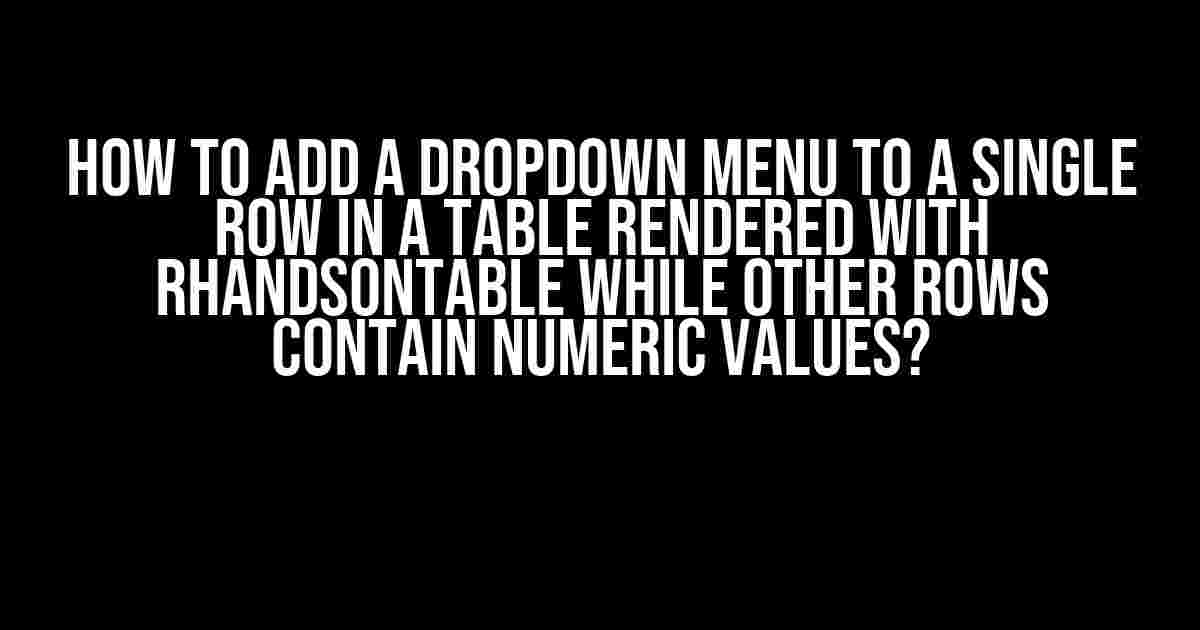If you’re working with tables in your web application, you might have encountered a situation where you need to add a dropdown menu to a single row in a table, while other rows contain numeric values. This can be a bit tricky, especially when using libraries like rhandsontable, which is designed for rendering and editing tables with numeric data. In this article, we’ll show you how to achieve this feat with ease.
Understanding the Problem
The Challenge with rhandsontable
Rhandsontable is an excellent library for working with tables, but it’s primarily designed for numeric data. By default, it doesn’t support adding dropdown menus or other non-numeric elements to specific rows or columns. This means you need to find a way to customize rhandsontable to accommodate your requirements.
The Solution
Fortunately, rhandsontable provides a way to customize its behavior through the use of renderers and editors. A renderer is a function that determines how a cell is displayed, while an editor is a function that determines how a cell is edited. By creating a custom renderer and editor, you can add a dropdown menu to the “Category” column.
Step 1: Define the Dropdown Options
First, define the options for your dropdown menu. Create an array of objects, where each object represents an option:
const dropdownOptions = [
{ value: 'Option 1', label: 'Option 1' },
{ value: 'Option 2', label: 'Option 2' },
{ value: 'Option 3', label: 'Option 3' },
// Add more options as needed
];Step 2: Create a Custom Renderer
Create a custom renderer function that will display the dropdown menu in the “Category” column:
const categoryRenderer = (instance, td, row, col, prop, value, cellProperties) => {
const select = document.createElement('select');
dropdownOptions.forEach((option) => {
const optionElement = document.createElement('option');
optionElement.value = option.value;
optionElement.text = option.label;
select.appendChild(optionElement);
});
td.appendChild(select);
return td;
};This function creates a `
Step 3: Create a Custom Editor
Create a custom editor function that will allow users to edit the dropdown menu:
const categoryEditor = (instance, td, row, col, prop, value, cellProperties) => {
const select = document.createElement('select');
dropdownOptions.forEach((option) => {
const optionElement = document.createElement('option');
optionElement.value = option.value;
optionElement.text = option.label;
select.appendChild(optionElement);
});
select.value = value;
td.appendChild(select);
return select;
};This function creates a `
Step 4: Configure rhandsontable
Now, configure rhandsontable to use your custom renderer and editor:
const hot = new Handsontable(container, {
data: [
['Category', 'Value'],
['', 10],
['', 20],
['', 30],
],
columns: [
{
data: 'category',
type: 'custom',
renderer: categoryRenderer,
editor: categoryEditor,
},
{
data: 'value',
type: 'numeric',
},
],
});In this example, we’re creating a table with two columns: “Category” and “Value”. The “Category” column uses the custom renderer and editor, while the “Value” column uses the default numeric editor.
Result
With these steps, you should now have a table with a dropdown menu in the “Category” column, while the “Value” column contains numeric values. Users can select an option from the dropdown menu, and the value will be displayed in the cell.
| Category | Value |
|---|---|
|
|
10 |
|
|
20 |
|
|
30 |
Tips and Variations
Here are some additional tips and variations to consider:
- Dynamic Dropdown Options: Instead of hardcoding the dropdown options, you can fetch them dynamically from a database or API.
- Conditional Formatting: You can use rhandsontable’s conditional formatting feature to highlight cells based on the selected dropdown option.
- Multiple Dropdown Columns: You can add multiple dropdown columns to your table by creating separate custom renderers and editors for each column.
- Validation: You can add validation logic to ensure that users select a valid option from the dropdown menu.
Conclusion
In this article, we’ve shown you how to add a dropdown menu to a single row in a table rendered with rhandsontable, while other rows contain numeric values. By creating custom renderers and editors, you can achieve this feat with ease. Remember to explore the additional tips and variations to take your table to the next level.
Happy coding!
Frequently Asked Question
Got stuck while trying to add a dropdown menu to a single row in a table rendered with rhandsontable? Don’t worry, we’ve got you covered! Here are some frequently asked questions and answers to help you out:
Q1: Can I add a dropdown menu to a single row in rhandsontable?
Yes, you can! You can use the `formatter` option in rhandsontable to specify a custom formatter for a specific row or cell. This allows you to render a dropdown menu in a cell, while keeping the rest of the table numeric.
Q2: How do I define the options for the dropdown menu?
You can define the options for the dropdown menu by creating an array of objects, where each object represents an option. For example, `[ {id: 1, name: ‘Option 1’}, {id: 2, name: ‘Option 2’} ]`. You can then pass this array to the `formatter` function to render the dropdown menu.
Q3: Can I style the dropdown menu to match my table’s design?
Absolutely! You can customize the appearance of the dropdown menu by using CSS to target the dropdown menu’s HTML elements. You can also use rhandsontable’s built-in styling options to match the menu’s design to your table’s design.
Q4: How do I handle selection changes in the dropdown menu?
You can handle selection changes in the dropdown menu by adding an event listener to the dropdown menu’s `onChange` event. This will allow you to capture the selected value and perform any necessary actions, such as updating the table’s data or triggering an API call.
Q5: Are there any limitations to using a dropdown menu in rhandsontable?
While rhandsontable is highly customizable, there may be some limitations to using a dropdown menu in certain scenarios. For example, if you have a large number of options or complex logic requirements, you may need to use a more specialized library or custom solution. However, for most use cases, rhandsontable’s dropdown menu support should suffice.

